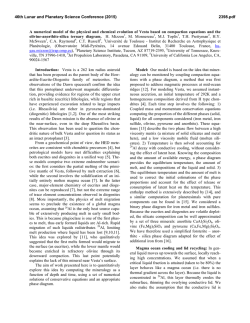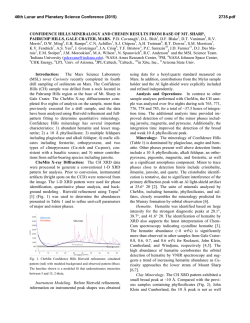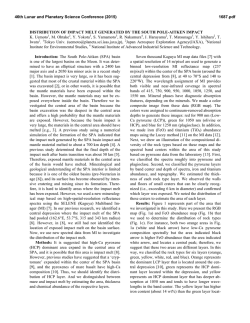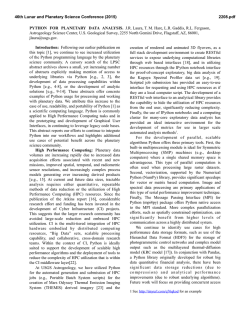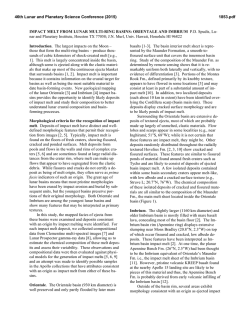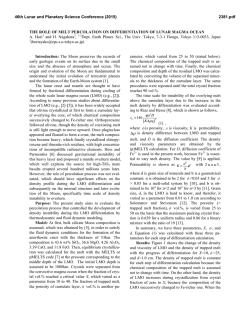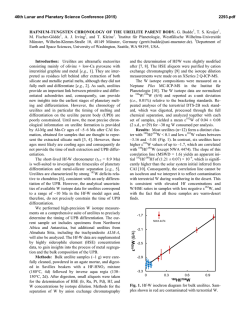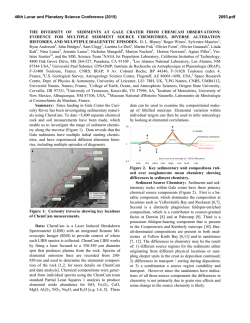
2686 - USRA
46th Lunar and Planetary Science Conference (2015) 2686.pdf MINERALOGY, PETROLOGY, CHRONOLOGY, AND EXPOSURE HISTORY OF THE CHELYABINSK METEORITE AND PARENT BODY. K. Righter1, P. Abell1, D. Agresti2, E. L. Berger3, A.S. Burton1, J.S. Delaney4, M.D. Fries1, E.K. Gibson1, R. Harrington5, G. F. Herzog4, L.P. Keller1, D. Locke6, F. Lindsay4, T.J. McCoy7, R.V. Morris1, K. Nagao8, K. Nakamura-Messenger1, P.B. Niles1, L. Nyquist1, J. Park4, Z.X. Peng9, C.Y.Shih10, J.I. Simon1, C.C. Swisher, III4, M. Tappa11, and B. Turrin4. 1NASA-JSC, Houston, TX 77058; 2 Department of Physics, University of Alabama at Birmingham, Birmingham, AL 35294-1170; 3GeoControl Systems Inc.– Jacobs JETS contract – NASA JSC; 4Rutgers Univ., Wright Labs-Chemistry Dept., Piscataway, NJ; 5UTAS – Jacobs JETS Contract, NASA-JSC; 6HX5 – Jacobs JETS Contract, NASA-JSC; 7Smithsonian Institution, PO Box 37012, MRC 119, Washington, DC; 8Laboratory for Earthquake Chemistry, University of Tokyo, Hongo, Bunkyoku, Tokyo 113-0033, Japan; 9Barrios Tech – Jacobs JETS Contract, NASA-JSC; 10Jacobs JETS Contract, NASAJSC; 11Aerodyne Industries – Jacobs JETS Contract, NASA-JSC. Introduction: The Chelyabinsk meteorite fall on February 15, 2013 attracted much more attention worldwide than do most falls [1-3]. A consortium led by JSC received 3 masses of Chelyabinsk (Chel-101, -102, -103) that were collected shortly after the fall and handled with care to minimize contamination. Initial studies were reported in 2013 [4]; we have studied these samples with a wide range of analytical techniques to better understand the mineralogy, petrology, chronology and exposure history of the Chelyabinsk parent body. Oxidation and weathering: The samples exhibit little to no oxidation: Mössbauer and Raman spectrometry indicate their fresh character. Mass spectrometry reveals a low but clearly detectable level of terrestrial organics indicating that despite the rapid collection and care of handling some terrestrial contamination is present. Mineralogy and petrology: Mineralogy, petrology, bulk chemistry and magnetic susceptibility measurements all indicate these masses are LL chondrite material [4]. However, detailed studies show that the masses contain three distinct lithologies (Figure 1). A light colored lithology is LL5 material that has experienced shock at levels near S4, based on mineralogy and textures. A second lithology consisted of shock darkened LL5 material in which the darkening is caused by melt veins, and metal-troilite veins distributed along grain boundaries. A third lithology is an impact melt breccia that formed at high temperatures (~1600 ºC), and experienced rapid cooling and degassing of S2 gas. Shock level S4 was experienced by the LL5 lithology (<20 to 30 GPa) but slightly higher pressures (up to 38 GPa) are suggested by high resolution imaging of textures in impact melt veins (Figure 2), as compared to results of shock experiments [20]. Chronology: Portions of light and dark lithologies from Chel-101, and the impact melt breccias (Chel-102 and Chel-103) were prepared and analyzed for Rb-Sr, Sm-Nd, and Ar-Ar dating. Results yielded ages that cluster at ~264-312 Ma, 716-1014 Ma, and 1112–1464 Ma thus indicating a complex history of impacts and heating events (Figure 3); these ages are consistent with other studies of Chelyabinsk [1, 5-10]. The wide range of ages indicates the Chelyabinsk parent body did not experience post-shock annealing that other ordinary and R chondrites have experienced [1114]. In addition, the specific ages do not include a 4.2-4.3 Ga impact event identified in other LL chondrites [15]. Exposure history: Finally, noble gases and Sm isotopic compositions were measured on these same aliquots to determine space exposure history. Most LL chondrites have yielded CRE ages of 6 to 50 Ma [16], but Chelyabinsk yields 1 Ma (also [17-19]). This young age, together with the absence of measurable cosmogenic derived Cr, and a barely detectable neutron capture effect in Sm for Chel-101, indicate that Chelyabinsk may have been derived from a recent breakup event on an NEO of LL chondrite composition. References: [1] Popova, O.P., et al. (2013) Science 342, 1069-1073; [2] Borovicka, J. et al. (2013) Nature503, 235–237; [3] Brown, P.G. et al. (2013) Nature 503, 238–241; [4] Righter, K. et al. (2013) Edmonton MetSoc, MaPS Supplemenet, #5235; [5] Lindsay, F. et al., (2015), this meeting; [6] Bouvier, A. (2013) Large Meteorite Impacts and Planetary Evolution V, #3087; [7] Beard, S.P. et al. (2014) 45th LPSC, 46th Lunar and Planetary Science Conference (2015) Figure 1: X-ray map of thin section of Chel-102,16. Red = Fe, dark blue / purple = Mg, green = Si, light blue = Ca, magenta = Ni, yellow = S, and white = Ti. Figure 2 (top): Bright-field STEM image from a FIB section extracted from a region of shock melt in Chelyabinsk. The metal and sulfide inclusions (dark, round grains) are sub-micrometer in size and heterogeneously distributed. Figure 2 (bottom): Bright-field STEM image from a region of shock melt with nanophase inclusions (left) and corresponding composite x-ray map (RGB=Fe S and Si) (right). 2686.pdf #1807; [8] Lapen, T.J. et al., (2014) 45th LPSC, #2561; [9] Galimov, E.M. et al. (2013) Geokhimiya, 51, 580–598; [10] Bogolomov, E.S. et al., (2013) Doklady Earth Sciences 452, Part 2, 1034–1038; [11] Rubin, A.E. and Jones, R.H. (2003) MAPS 38, 1507– 1520; [12] Rubin, A.E. (2014) MAPS 49, 1057–1075; [13] Righter, K. and Cosca, M. (2014) Goldschmidt Conference; 8-13 Jun. 2014; Sacremento, CA; United States; [14] Rubin, A.E. (2004) GCA 68, 673-689; [15] Swindle, T.D. et al. (2014) Advances in 40Ar/39Ar Dating: from Archaeology to Planetary Sciences (eds Jourdan, F., Mark D. F. & Verati, C.), Geological Society, London, Special Publications 378, 333-347; [16] Eugster, O. et al. (2006) Meteorites and the early solar system II, 1, 829-851; [17] Haba, M.K. et al. (2014) 45th LPSC, #1732; [18] Nishiizumi, K. et al. (2013) MAPS Supplement, #5260; [19] Busemann, H. et al. (2014) 45th LPSC, #2805; [20] Horz, F. et al. (2005) MAPS 40, 1329-1346. Figure 3: Impact age probability distribution for Chelyabinsk. Red curve represents the summation of the Gaussian distribution of each individual age analysis The age data of Pb-Pb, U-Pb, Ar-Ar (plateau and “integrated” ages), K-Ar, and U-He [1, 5-8, this study] are more precise and are shown by sharp peaks. The less precise Sm-Nd and Rb-Sr isochron [9,10, this study] are shown by broad humps. At least eight impact events (e.g. ~4.53 Ga, ~4.45 Ga, ~3.7 Ga, ~2.8 Ga, ~1.4 Ga, ~312 Ma, and ~27 Ma) are identified for Chelyabinsk. The Sm-Nd and Rb-Sr isotopic systems in Chelyabinsk are very complex and are highly disturbed which is consistent with its having experienced many events of thermal metamorphism and impact resetting after its accretion.
© Copyright 2025
